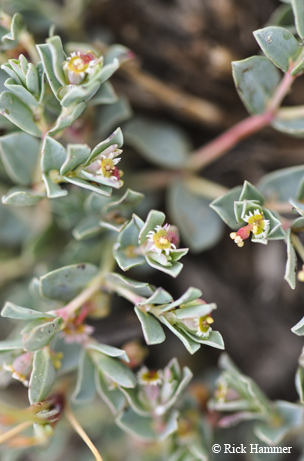
Flora Fact: Rolling Plains Rarity
Dwarf broomspurge can be found in only two Texas counties.
By Rick L. Hammer
Most of the plants that you read about here are relatively common and often found throughout most of Texas. Dwarf broomspurge (Chamaesyce jejuna), sometimes called dwarf sandmat, is an exception. While not listed as a federally endangered plant species, it’s found only in Nolan and Mitchell counties in the Rolling Plains west of Abilene. Dwarf broomspurge is a Texas endemic, which means it does not occur anywhere outside of our state.
As a botanist and conservation biologist, I’ve had the pleasure of conducting research on this species for the past two years, mainly trying to find additional locations. While I didn’t find new populations of dwarf broomspurge, I’ve been able to monitor and study the known populations in order to determine what conservation biologists call a threat assessment or general prognosis for the future. The Texas Parks and Wildlife Department lists dwarf broomspurge as one of the “species of greatest conservation need.” It’s no wonder, since in both Nolan and Mitchell counties, the plants are found along only three stretches of roadway, each less than a mile in length. That’s a pretty precarious situation for survival.

While many native plants display showy flowers, dwarf broomspurge’s flowers are not very noticeable. Plants in the Euphorbiaceae family typically lack the familiar petals of most flowers. The male and female flower parts are grouped in a special cup or container called a cyathium, which has glands along its rim. To the untrained eye, the glands could be easily mistaken for petals. Flowers appear from mid-March through July.
Dwarf broomspurge is a low-growing perennial, with opposite leaves on stems that lie close to the ground and spread out from the center of the plant. The tiny leaves are ovate (egg-shaped) or elliptical, about 4 to 6 millimeters long. The plants are always found growing on limestone outcrops or ridges.
As a casual observer, you may never encounter dwarf broomspurge in the wild. However, all native plant enthusiasts can take pride in a species that can be found in only two small locations in Texas, making it a unique and wonderful part of our natural heritage and biodiversity.
Future research, partially funded by TPWD’s Conservation License Plate Grant Program, will continue the search for new populations of this plant in Texas..
» Like this story? If you enjoy reading articles like this, subscribe to Texas Parks & Wildlife magazine.
Related stories

